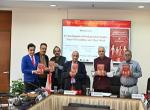Vivekananda International Foundation (VIF) organised a Round Table Discussion (RTD) on ‘Achieving Global Competitiveness-Improving Ease of Doing Business’ on 14 February 2020. Dr Arvind Gupta, Director VIF, opened the floor by laying the purpose of the roundtable, which was to analyse the general conditions of doing business with a focus on Steel Industry and the Strategic Sector of India. Amongst the participants were Mr. Binoy Kumar, Steel Secretary, Chanakya Chaudhary, Vice President – Corporate Services, Tata Steel Limited and Mr. JD Patil, L&T besides VIF Faculty and a number of strategic experts.
India has a robust Steel Industry and Tata Steel has been at the forefront, since liberalisation in 1991. Today, India has replaced Japan as the second-largest steel-producing country in the world. The growth in the Indian steel sector has been driven by domestic availability of raw materials such as iron ore and cost-effective labour.
However, the domestic steel consumption growth has decelerated to 3.07 per cent in FY2020 as compared to 7.9 per cent in FY2019, on account of a substantial reduction in demand. As a result, steel production in India has receded and the industry has become vulnerable to cheaper imports. It has been importing minuscule steel products for usages such as needles, pins, scissors and other surgical equipment. Naturally, the question that arises is despite being the second-largest producer why the domestic industry is unable to meet the demand for such products? Figures show India dwindling at the bottom rungs of the consumption ladder with a per capita consumption of only 70.9 kg, showing a notable rift with the global figure of 224.5 kg. It has also seen a steep decrease of 33.9% in its exports, clocking only 6.36 MT in 2018–19. In contrast, imports saw an increase of 4.7% and stood at 7.83 MT. Consequently, the country has become a net importer in the last financial year.
The Indian steel industry is highly consolidated. About 60% of the crude steel capacity is placed with integrated steel producers (ISP). But there is an increasing presence of secondary steel producers (non-integrated steel producers) manufacturing steel through scrap route. Moreover, these non-integrated steel producers have enhanced dependence on imported iron. These small players (SMEs) must look towards the domestic market to fulfil their iron demands. The Ministry of Steel has introduced certain policy boosts to stimulate demand in the sector. It has asserted the development and usage of slurry pipelines for iron-ore transportation and other raw materials to improve logistics facilities and freight cost. The government has recognised the crucial role of the steel industry in India’s rise to a $5 trillion economy and proposed several new policies in the sector;
- A Policy Framework on setting-up of value addition focused Steel Clusters- Intended to encourage SME’s (semi-medium size enterprises) in the steel sector, this would expand production of value-added products, facilitate additional employment opportunities and foster import substitution.
- Establishment of Steel Import Monitoring System (SIMS)- An institutional apparatus in association with Directorate General of Foreign Trade (DGFT) has been conceived for monitoring steel imports. The monitoring would generate valuable information for the Indian domestic steel industry in responding to market conditions in a dynamic manner.
- Promotion of Research and Development (R&D) for the Indian steel sector- To revive the sector, the government has also focused on R&D. Moreover, given its push for the ‘Make in India’ programme, the outlook for the sector remains positive.
- Introduction of Steel Scrap Policy- The government has introduced the Steel Scrap Recycling Policy to ensure a reduction in imports and to assure the competitiveness of Indian Steel Sector.
Amid the price slump, the government needs to focus on ‘the cost of businesses as a part of its efforts at improving the ‘ease of doing businesses’. The remedies required are ‘transformational’ types; to make industries, particularly the manufacturing sector, more competitive in the prevailing market. The discussion drew attention to the current distresses in the Steel Industry:
- Financial Viability - Steel is a capital-intensive sector. It requires about 7000 crores to build up 1 tonne of steel-making capacity through greenfield route. And the cost of finance is enormous compared to other developed countries like Korea, Japan and China. Indian steelmakers face a relative disadvantage compared to their competitors from the developed world.
- Land Acquisition- Manifold challenges come along with land availability and land cost. The complexities of Land Acquisition, Rehabilitation and Resettlement Act (LARR Act, 2013) makes large-scale acquisitions of land for steel problematic due to public resistance. The way forward would be to engage with the community in confidence-building measures.
- Logistics- Management of logistics requirements, for Indian steelmakers, is quite challenging and costly. The freight cost of moving material (both raw & finished steel) through the railways is quite high. For every 1 tonne of steel produced, roughly 3 tonnes of raw material needs to be transported.
- Taxation- The iron-ore royalty rates have increased in India, nearly to 15%, whereas the global rates vary between 3-7 %. Moreover, the Mining and Minerals Development Regulations Act (MMDR Act, 2015) has mandated additional royalty payments to the District Mineral Fund (DMF). This imposition would cause an increment of one-third of royalty for the newly auctioned mines. Frequent changes in royalty and taxation lead to disruptions in mining activity and de-stabilises the steel sector.
- System of Mine Allocation- Exploration, in itself, is not a paying proposition and needs to be incentivised. The new provision for ‘auction only’ under MMDR Act needs to be substituted with a system that would boost exploration with a promise of mining rights in case of success.
- Project Implementation: There are many challenges faced by Indian Steel Manufacturers in their project implementations due to excessive delays in clearances and grant of approvals. The industry has been advocating for a ‘single window’ approach for acquiring a grant of approvals. However, the rigidity of the legal framework and lack of coordination between the central and state governments forces the procedures into departmental silos. For efficient project implementation, a coordinated multi-sectoral approach is required.
The RTD raised many pragmatic insights and concerns regarding India’s Defence Sector. The government’s ‘Make in India’ initiative in the defence sector has focused on the indigenous production of defence equipment and prioritisation of local procurement. Earlier, the industry was a near-monopoly but the revised Defence Procurement Policy of 2016 encouraged the private sector participation. The discussion also highlighted the key challenges faced by private companies in the defence segment. Especially, in the aerospace industry, in which the availability of standard-grade raw material at competitive prices and shorter lead times create restraints. The Original Equipment Manufacturers (OEMs) take too long to develop and to certify the advanced composite products. An inadequacy persists in the implementation of development and production partner approaches across the aerospace and the defence sector in India. The private players are denied opportunities to bid and there is an atmosphere of continued bias towards the Public Sector Units (PSUs).
The discussion was followed by a vibrant round of questions and answers.






Post new comment